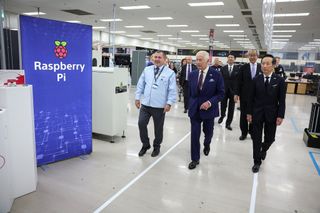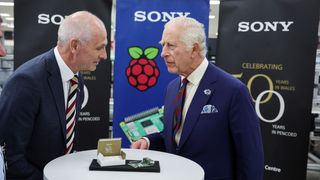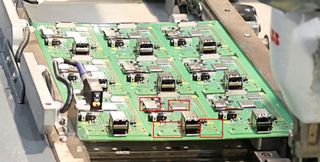King Charles III packs 'fifty millionth Raspberry Pi' during visit to Sony factory
Even royalty want a slice of Pi

Update 7/13 01:32 PDT
Raspberry Pi co-founder and CEO has responded to our enquiry and keenly states that His Majesty The King's visit "was first and foremost a wonderful piece of recognition for the work that Sony has done over half a century in Bridgend and Pencoed."
As for the 50 million units number, this relates to the number of unit produced in the Pencoed factory. Some early units were made in China, and the Raspberry Pi Pico and Pico W are made in Sony's factory in Inazawa, Japan. We have updated the story below to include this data.
Updated Story
On a recent visit to Sony UK's Technology Center in Pencoed, Wales. His Majesty King Charles III packed the "fifty millionth Raspberry Pi". But during the tour, The King was seen reviewing older models of Raspberry Pi and pictured with Raspberry Pi Chief Commercial Officer, Mike Buffham. A special edition Raspberry Pi 5 was presented in a gold box to mark the achievement for Sony.
The King's visit coincided with the 50th anniversary of the Pencoed site, which originally made Sony's Trinitron televisions. During the early days of Pi, Sony worked with Raspberry Pi to move production of the credit-card-sized computers to the United Kingdom.

🖥️ The King packed the fifty millionth @Raspberry_Pi, a compact, affordable, and versatile computer that empowers young people to learn coding and explore technology through hands on projects. pic.twitter.com/9kChyjL53cJuly 11, 2024
The King, who was the Prince of Wales at that time, opened the first site in Bridgend, back in 1974. Since then, Sony has produced a myriad of technology and worked with the local community to provide training and jobs.
Raspberry Pi production moved to Sony's Pencoed Technology Center back in 2012, the early days of the Raspberry Pi. At that time, Sony were making the original model of Raspberry Pi, and I've seen production of these units with my own eyes. Since those early days, Raspberry Pi production has been ramped up, and many different models have been made there.
In the X (formerly Twitter post) we can see The King walking around the factory, looking at camcorders, and talking with staff members. But there was one picture that caught our eye. The King is seen reviewing a process line full of Raspberry Pi boards. These boards are being built by robots, an investment that Sony has made in the years since I was there. Back then, many of the original boards had more human input to their creation, including a final check of soldering and chip placement. These tasks are largely now undertaken by AI-based systems.
Stay On the Cutting Edge: Get the Tom's Hardware Newsletter
Get Tom's Hardware's best news and in-depth reviews, straight to your inbox.

But, what model of Raspberry Pi is The King overseeing? The new flagship Raspberry Pi 5? Well it seems not. Let's go full CSI and investigate.
Zooming in, we can see the silver packages for the System on Chip (SoC) and Wi-Fi. There are two USB 2.0 ports soldered, full size HDMI and a 3.5mm composite jack. So we're looking at an older model of Raspberry Pi. Could it be the Raspberry Pi 4? Looking to the left of the soldered USB ports, we see two holes, used as anchor points. The USB ports use four holes for anchor points, all being soldered to the Pi. So the two holes on the left must be for Ethernet. The port placement, silver SoC, and Wi-Fi indicates that these are Raspberry Pi Model 3B+.




You may be thinking "Are you sure its not a Raspberry Pi 4?". The answer is, I am quite sure and above are the images to backup my claims. For the Raspberry Pi 4, the Ethernet port was moved to the other side of the USB ports, breaking compatibility with the best Raspberry Pi cases. For the new flagship Raspberry Pi 5, the Ethernet port was moved back, causing another compatibility issue for case makers.

Where is the 50 millionth Raspberry Pi that The King packed? We're not entirely sure. The photo with Mike Buffham celebrates Sony's 50 years in Wales, and the Raspberry Pi in the gold box is clearly a Raspberry Pi 5. We can clearly see the heatspreader that goes over the SoC. To confirm the location of this special Raspberry Pi, we have reached out to Raspberry Pi Co-Founder and CEO Eben Upton CBE (Commander of the Order of the British Empire). Upton was appointed a CBE in the 2016 Birthday Honours for his work in business and education. This appointment was made by the late Queen Elizabeth II, mother of His Majesty The King. We have also contacted The Royal Families' PR team for comment.
Keen-eyed readers will be thinking, "I thought that Raspberry Pi had sold 61 million units?" and you are correct. Back in February 2024 we asked Upton for the latest sales figures and he confirmed that 61 million units had been sold. This includes 4 million Raspberry Pi Picos. The 50 million refers to the number of units manufactured in the Pencoed factory. Earlier models of Raspberry Pi were made in China, and the Raspberry Pi Pico and Pico W are made in Inazawa, Japan.
Les Pounder is an associate editor at Tom's Hardware. He is a creative technologist and for seven years has created projects to educate and inspire minds both young and old. He has worked with the Raspberry Pi Foundation to write and deliver their teacher training program "Picademy".
-
bit_user One thing I respect about Pi is their commitment to doing UK-based manufacturing.Reply
Similarly, something I like about the ODROID boards is that they're South Korean, although I'm not sure where their manufacturing is done. UpBoard is USA-based (again, not sure about manufacturing). -
edzieba ReplyKeen-eyed readers will be thinking, "I thought that Raspberry Pi had sold 61 million units?" and you are correct. Back in February 2024 we asked Upton for the latest sales figures and he confirmed that 61 million units had been sold. This includes 4 million Raspberry Pi Picos. We've asked Upton to help us understand where the 50 million figure comes from.
Could be "50 millionth Raspberry Pi to come off of the Pencoed line" rather than "50 Millionth Raspberry Pi manufactured globally", as there have been other lines used in the past (both prior to the move to Pencoed, and for surge capacity and supply chain diversity when demand spiked during COVID).
Most Popular


